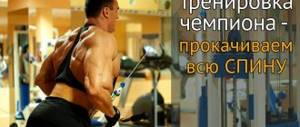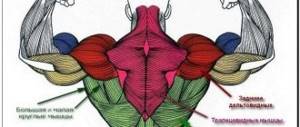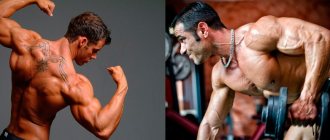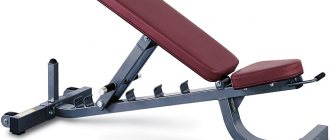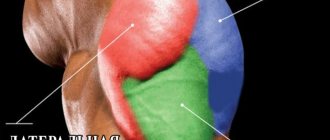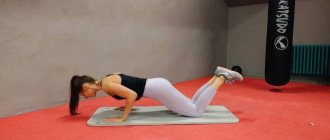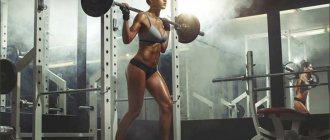Back muscle training is a very important and difficult task especially when the back lags behind. In general, the larger the muscle group, the more difficult it is to specialize in it, since a lot of resources are spent on both training and recovery. This training program involves four sessions per week, of which two are designed to work the back muscles. It is recommended to break down your back training by goals, and not only in this case. The bottom line is that the back consists of a whole complex of muscles; most often, the deadlift is considered a basic exercise for the back, but this exercise only uses the long back muscles, while training the legs perfectly. If you want a wide back, then attention should be paid to the latissimus and teres dorsi muscles.
Back training, in this case, will work on either the thickness of the back or its width. Training for the width of the back will be difficult, and for the width it will be easier, although this division, of course, is very arbitrary. To work out the width of the back, the athlete should use horizontal pull-downs, and to work out the width, use vertical pull-ups. During a heavy workout, the rep range ranges from 6 to 10, and during a light workout from 10 to 15. This is not about recruiting different types of muscle fibers , since time under tension is not the only factor that determines which fibers and method energy supplies will be involved. The bottom line is that such microperiodization will relieve the central nervous system, and will also allow you to get the most out of the exercises, since horizontal rows work better in a low repetition range, and vertical rows in a high one.
Content
- 1 Back - exercises and training features 1.1 Anatomy and functions
- 3.1 Basic exercises for the back
- 4.1 Exercises at home
- 5.1 Exercises at home
- 6.1 Exercises at home
Anatomy and function of the muscles of the upper back
Anatomically, the muscles of the upper back are represented by two largest areas:
- Trapezoidal.
- Latissimus (upper part).
Also, the rear deltas are often referred to as the “upper back”, since they are involved in most exercises. But from an anatomical point of view this is incorrect.
The trapezius muscles (more triangular in shape when considered individually) are responsible for moving the shoulder blades. They are attached to the back of the head at the top and the spine at the bottom. They have a pronounced effect on posture and keeping the back straight at the top.
The latissimus muscles occupy almost the entire back in area and are located on both sides of the spine. They are shaped like wings. It is important to understand that the “upper back” refers to only the part of the lats, which is located under the trapezius. The main functions of the muscle are adducting the shoulder to the body and pulling the arm back, internal pronation.
Back - exercises and training features[edit | edit code]
Yuzhakov Anton BEST EXERCISES FOR LATISM MUSCLES
The best exercises for the back
Back muscles: 1 - trapezius, 2 - latissimus, 3 - erector spinae Bodybuilding. Authors: R. T. Raevsky Bodybuilding. Authors: R. T. Raevsky
Training the back muscles contributes to the development of its V-shaped relief shape, which makes the waist and hips visually narrower, thereby making the figure look more aesthetically pleasing. The back muscles are large muscles, which makes them one of the main ones in bodybuilding, since without well-developed back muscles you will not have a harmonious figure, and your strength in squats or deadlifts will remain low.
Developed back muscles are also very important for the formation of correct and beautiful posture, since these muscles play a major role in stabilizing the spinal muscles.
It is due to the low tone of the trapezius muscles that the shoulders are retracted forward and a stoop develops. Read more:
- Posture correction – biomechanical basis of postural disorders.
- Stage 1 – general recommendations for changing lifestyle and movement patterns.
- Stage 2 – gymnastic exercises and stretching, necessary to eliminate muscle hypertonicity and mobilize the musculoskeletal system.
- How to correct posture (exercises) - building strength training aimed at strengthening target muscles.
Anatomy and functions[edit | edit code]
Read more:
Back muscles
The back muscles are located in several layers, so they are divided into deep and superficial, which, in turn, are also located in two layers. The appearance of the back is determined by three main muscles: the latissimus muscles, the trapezius muscles and the lower back muscles.
Anatomical structure of the back muscles
The back is made up of bones, joints, nerves, muscles and connective tissue. They all help keep the vertebrae in the spinal column straight. Actually, the spine is divided into three parts: the cervical region, the thoracic region, and the lumbar region. Incorrect bending or turning when lifting heavy objects can damage the discs between the vertebrae. To keep your back healthy and strong, you need to maintain an upright posture all day long, not just when lifting heavy objects.
The back muscles include the following groups: trapezius - (this is the upper part of the back), rhomboids - (located immediately below the trapezius), latissimus (the largest group of the lower back), teres major and minor (located under the latissimus) and muscles - spinal extensors (those that straighten the lower back, the longest, divided into many subtypes).
The chest and abdominal muscles play a key role in the physical development and strengthening of the muscles of the back of the body. The rectus abdominis (six pack abs) and obliques (located on the side of the torso) stabilize the spine and help with heavy lifting. Typically, each back exercise involves all or several specific groups.
Features of back training[edit | edit code]
Back. Anatomy and training features
Yuzhakov Anton. Back training program
- If you do a split workout, you can train your back on the same day as your triceps, legs, biceps or shoulders.
- People whose work involves heavy physical labor are recommended to perform no more than three to four sets per workout. If you do not experience daily stress on your back, then in one workout you need to perform 6-8 sets (the sum of the sets of all exercises) on your back.
- Usually, two or three back exercises are enough to achieve good results. To increase relief and muscle mass, perform 10-15 repetitions. When exercising to develop strength, reduce the number of repetitions to 5-7.
- Exercises on the back muscles are among the most traumatic; most often, disability in bodybuilding is associated with the spine: osteochondrosis, herniated intervertebral discs, spondylolisthesis, pinched spinal nerve roots, and so on. All these diseases are associated with irrational training and excessive stress on the spinal column.
- If you are new to bodybuilding, use light weights in the initial stages, even if you feel like you can lift much more. In order to subject your back to high loads, you first need to strengthen the muscular-ligamentous apparatus, which will protect the spine from damage.
Wide back[edit | edit code]
These workouts are part of a weekly split that includes training other muscle groups. Rest between back workouts is at least 72 hours.
PULL-UPS
START
: Assume a hanging position on the bar.
The grip is wide. EXECUTION
: Raising the body is carried out due to a strictly isolated movement of the elbows to the bottom. Do not pull yourself to the bar with your arms. This defeats the purpose of the exercise. Per set, do 8-10 repetitions. If you don’t have enough strength for a full set, perform it in the “rest-pause” style, lowering yourself onto a low support in between.
BELT TO THE BELT
START
: Assume a bent-over position, holding the barbell with straight arms at your hips.
Keep your back straight. Don’t throw your head back, keep it “in line” with your spine. EXECUTION
: By strictly raising your elbows upward, pull the barbell to your waist. Without pausing, return the barbell to the starting position in front of your hips.
DUMBBELL PULL UP
START
: Take a position of support on a straight arm and knee of the same leg.
Extend your other arm and hold the dumbbell near the floor with a neutral grip. EXECUTION
: By raising your elbow upward, pull the dumbbell to your waist. Without pausing, return the dumbbell under control to the starting position. Complete all given reps with one arm, then switch arms.
WIDE PULL TOP
START
: Place your knees under the supports of the machine and firmly fix your body in a sitting position.
Ask your partner to hand you the handle and grab the ends with a wide grip. EXECUTION
: Without tilting your body back, pull the handle towards your chest using an isolated downward movement of your elbows.
DON’T
! Do not do the exercise to “failure”! Use critical weights, but break off the sets for the repetition before “failure”.
T-BAR PULL
START
: Take the position of resting your chest on the support pad of the machine.
Grasp the handles and remove the weight from the supports. Extend your arms completely, holding the weight near the floor. Feel the strong stretch in your back muscles. EXECUTION
: Pull the weight towards you using an isolated upward movement of your elbows. Without pausing, return the weight to the starting position with your arms straight. Do not allow the arm muscles to participate in the pulling, otherwise the load on the back muscles will be significantly reduced.
SITTING TO THE BELT
START
: Take a sitting position on the machine bench and rest your feet on the footrests.
Straighten your arms completely and lean back slightly so that the pulley cable stretches. The weights must be removed from the support and held in place. EXECUTION
: Pull the handle to your belt by pulling your elbows back in an isolated manner.
Do not allow the arm muscles to participate in the pulling, otherwise the load on the back muscles will be significantly reduced.
Exercises for the latissimus dorsi[edit | edit code]
Back muscle training - wider and thicker
The most important muscles that take part in the formation of the back are the latissimus. They start in the back of the armpits and go down to the waist. It is the latissimus muscles that give the back a powerful cone-shaped appearance, visually increasing the width of the shoulders and narrowing the waist. Therefore, any athlete involved in bodybuilding tries to make great efforts to develop them. This is a real lifesaver for those who have naturally narrow shoulders; well-developed lats can solve this problem.
Exercises at home[edit | edit code]
Basic exercises:
- Pull-ups
- Pull-ups on the bar
- Pull-ups on the door
- Pull-ups
- Pull-ups on the bar
- Exercise with a tourniquet
- Simulation of lifting a barbell with a tourniquet
Exercises with weights[edit | edit code]
Basic exercises:
- Bent-over barbell row
- Barbell row to the waist
- Bent-over one-arm dumbbell row
- Bent-over barbell row
- Barbell row to the waist
- Barbell row to the waist
- Bent-over barbell row
- Bent-over one-arm dumbbell row
- Bent-over one-arm dumbbell row
Isolation exercises:
none
Exercises on simulators[edit | edit code]
Basic exercises:
- Wide grip pull-ups on the machine
- Head pull on a high block
- Seated row of block to the waist
- Horizontal block thrust
- Seated chest row
- Upper pulley to chest
- Head pull on a high block
- Abdominal row on the machine
- Wide grip pulldown
- Horizontal linkage
- Wide grip pull-ups on the machine
- Pull-ups
- Head pull on a high block
- Seated row of block to the waist
- Seated chest row
- Upper pulley to chest
- Upper pulley to chest
- Head pull on a high block
- Abdominal row on the machine
- Pull the lower block forward
- Wide grip pulldown
Isolation exercises:
none
How to properly pump up your back muscles
1Focus on multi-joint exercises
Calum's best advice is to start with multi-joint exercises.
This is the best route for beginners. That's how he started out. Calum believes that core exercises will not only help develop your back, but will also help with coordination and strengthen your core. Choose movements like deadlifts—which work your back, legs, and glutes—as opposed to isolation exercises like straight-arm cable rows. Another rule is never sacrifice technique for more weight. Throwing a bunch of iron onto a barbell to increase the size of your back on a barbell deadlift is a recipe for diminishing results, not adding mass.
Calum has been taught by many years of experience to monitor the technique of performing exercises. He says he's tried and used heavy weights before, both for deadlifts and bent-over rows, but it's not good for muscle building.
2Create a brain-muscle connection (neuromuscular connection)
To tone up his massive back, Calum focused on neuromuscular connections and the muscles began to grow.
Although he has always had a well-defined and prominent back, Calum hasn't always enjoyed training this specific body part. He would rather bench press or squat to strengthen his quads. But last year he noticed a difference in the width and thickness of his back, which prompted him to take action.
Calum has also recently created a strong mental connection with his back. He says the best thing about back training now is the brain-muscle connection that I have. He usually tries his best to activate his back muscles. Calum says he didn't know how to stretch before, but now he can do multiple stretches, which makes the workout much more effective.
3Pull, Pull, Pull
When it comes to your back, barbell rows and wide-grip pull-ups should come to mind. Calum believes that for a good, wide back, the bent over row is ideal because it initially targets the middle of the trapezius muscle, which lowers the center of your back.
Combine it with a lat pulldown to develop width. Think about your back during every workout to maximize the involvement of all fibers.
4Stretch and contraction
To build a powerful back, the key is that you stretch and contract every muscle at the peak of each set. Isometric exercises—such as stretching, counting to 5, and relaxation—help activate and fatigue this muscle.
Any isometric exercise increases the time the muscle is under load and strengthens the neuromuscular connection with each movement. The result is more than just a great mass!
The correct technique for performing the exercise and involving the maximum number of muscle groups and muscle fibers in the work will help pump up a massive back.
Are you ready to put these tips into action? Start working on your back using Calum's advice. Push yourself to lift heavy weights the way you need to, but stick to proper form and rest periods.
Exercises for the trapezius muscle of the back[edit | edit code]
The trapezius muscles begin at the base of the skull, radiate toward the shoulders, and run down between the shoulder blades. These muscles are extremely important for bodybuilders. There is no such thing as a harmonious figure with poorly developed trapezius muscles.
Exercises at home[edit | edit code]
Deadlifts are performed with available weights.
Weight-bearing exercises[edit | edit code]
Basic exercises:
- Chin pull
- Chin pull
- Bent-over dumbbell row
Isolation exercises:
- Shrugs
- Shoulder raise with dumbbells
- Shrugs
- Shrugs
- Shoulder raise with dumbbells
Exercises on simulators[edit | edit code]
Isolation exercises:
- Pulling the block to the side with both hands
- Pulling the block to the side with both hands
Exercises for the lower back muscles[edit | edit code]
The lower back is mainly represented by the erector spinae. When planning your training program, it is better to leave lower back exercises for the end of the workout. In addition to appearance, strengthening the lower back muscles has health benefits, as it is one of the weakest areas of a bodybuilder. By strengthening the lumbar muscles, the risk of spinal diseases is reduced: osteochondrosis, vertebral displacement and pinched nerves, since the muscular frame provides reliable support for the vertebrae.
To strengthen the lower back, beginners are recommended to perform deadlifts as the main exercise that affects almost all back muscles.
Exercises at home[edit | edit code]
Basic exercises:
Isolation exercises:
Weight-bearing exercises[edit | edit code]
Basic exercises:
- Deadlift
- Deadlift
- Forward bends with a barbell
- Deadlift
- Deadlift
- Deadlift
- Forward bends with a barbell
- Bent-overs with a kettlebell
- Single Leg Bent Squats
Isolation exercises:
Exercises on simulators[edit | edit code]
Basic exercises:
Isolation exercises:
- Hyperextension
- Hyperextension
Next exercise
This is an opportunity to create something that I think is incredibly important and that gets overlooked, and that is focused tension. I talked about this exercise in one of my previous articles where we chose the best row for the back. And we'll come back to the lats again with two variations of this exercise, these are my favorites. You have two options in it and you need to focus on how you do them.
First option
The first is a high block row with alternating arms. I do this by alternating hands to make the set last as long as possible. And the fact is that this exercise is ideal for training the lats throughout the entire range of motion.
I can extend my arm in front of my body and just like the Chin Up this is an excellent position for the lats - it gives them a full stretch and so I can:
- place your hand all the way behind your back, pressing it tightly to the side;
- use all functions of the lats;
- and even turn back a little, thereby expanding the possibilities of the exercise.
I can do this variation or this variation of vertical traction.
Second option
I call this the twisted upright row or the swing upright row. The meaning here is the same - we are not just doing it in the frontal plane, due to which you are limited in our amplitude of the ghost and will only be able to rotate the body a little. Here we lean further, thanks to which we can tighten the body, achieving a better ghost, and, consequently, a better contraction of the lats due to the large amplitude.
If you haven't tried all of this, then you need to do it and I promise you you will see results. And you won't have to sacrifice the weight you use for this - we can use the same weight, maybe only dropping one or two tiles, but you'll be able to get a much better cut. Again, this focused tension comes into play, especially when you want to gain more aesthetically and increase your strength and training performance.
Read also[edit | edit code]
- How to pump up a wide back
- Exercises for back muscles
- Exercises for the back and shoulders (for women)
- Back stretch
- Pull-ups for the back
- Back workout in the gym
- Back workout
- Back workout for girls
- Superset workout: chest back
- Mid back workout
- Back workout for girls
- Back muscle trainers
- Training program for beginners
- Training program for professionals
- Sports nutrition
- How to create a training program
- The best training programs for mass
- Muscle and Fitness 2011 No. 4 “Training the back muscles” - page 116.
- Muscle and Fitness 2011 No. 3 “Training for both the chest and back” - p. 134.
Preparing for the first lesson
Before the first lesson, you need to be examined (pass the necessary tests, do an ultrasound, go through the necessary specialists), and get advice from a therapist. If you do the exercises incorrectly, you can injure your spine and worsen your health.
If you are undergoing rehabilitation after any disease or surgery, you must consult a surgeon and therapist. After receiving medical reports, you can consult with a rehabilitation doctor or gym worker who can choose the ideal training program for you.
Before you start exercising, do not forget to stretch your muscles a little (this should involve bending the body and head, bending and other exercises). Remember that overexerting yourself during such activities is prohibited.
If you experience any pain in your back or lumbar region, stop playing sports immediately. The duration of classes should be from half an hour to one hour.
Effective exercises at home for the whole bodyAbdominal vacuum exercise - instructions on how to do it correctly at home. All the subtleties and secrets from the pros + 100 photos
Machine leg extensions are the best technique for performing exercises in a sitting position. All the subtleties, secrets + instructions for you!
When exercising every other day, you will get ideal support for your back muscles. To strengthen them and lose weight, you need to start with cardio exercises and end the workout with strength exercises.

